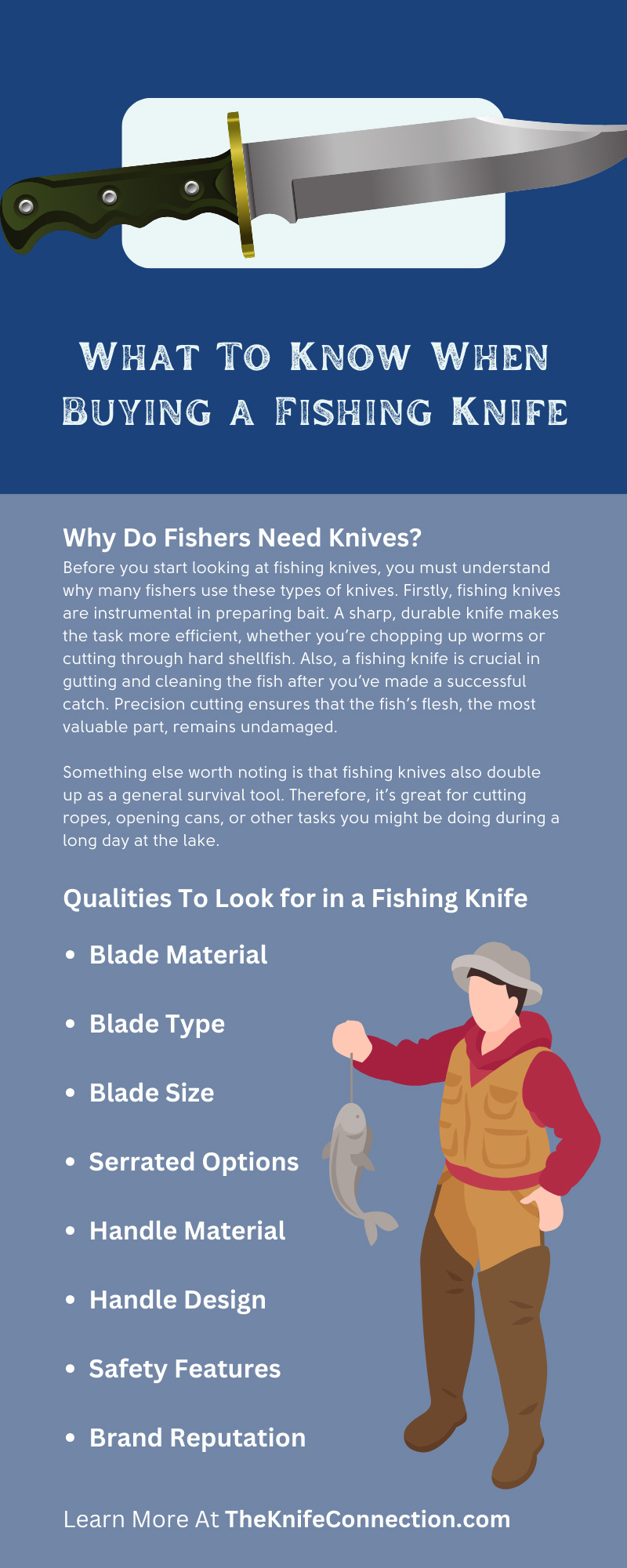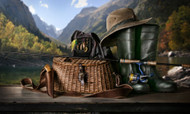What To Know When Buying a Fishing Knife
Jan 23 2024 - 11:57
Fishing is one of the most popular outdoor recreational activities. Because of its popularity, new people are trying it out for the first time every day. However, unlike some outdoor hobbies, you must ensure you have the right equipment. While some items might seem obvious, like a fishing pole and bait, not all of them will be for newcomers.
The fishing knife is one such overlooked piece of equipment. While some knives are specific for this pastime, many others exist that’ll work perfectly for it. Our guide on what to know when picking out a fishing knife will be quite useful for those dipping their toes into the world of fishing.
Why Do Fishers Need Knives?
Before you start looking at fishing knives, you must understand why many fishers use these types of knives. Firstly, fishing knives are instrumental in preparing bait. A sharp, durable knife makes the task more efficient, whether you’re chopping up worms or cutting through hard shellfish. Also, a fishing knife is crucial in gutting and cleaning the fish after you’ve made a successful catch. Precision cutting ensures that the fish’s flesh, the most valuable part, remains undamaged.
Something else worth noting is that fishing knives also double up as a general survival tool. Therefore, it’s great for cutting ropes, opening cans, or other tasks you might be doing during a long day at the lake. Also, a quick, clean cut is necessary to remove hooks to make the removal process easier and not cause unnecessary harm to the fish if you’re only doing catch and release. Hence, a reliable fishing knife plays a pivotal role in every fishing expedition.
Qualities To Look for in a Fishing Knife
Now that you understand the reasons for having a fishing knife, it’s time to learn about the primary qualities you’ll want to search for when picking one out. These are the most important things to know when buying a fishing knife, so be sure to review these traits closely to ensure you get the right type of blade for your needs.
Blade Material
The blade material is one of the critical factors to consider when buying a fishing knife. Typically, fishing knives consist of stainless steel, high-carbon steel, or titanium. Stainless steel is the most common material, and many prefer it due to its corrosion resistance and durability. High-carbon steel, on the other hand, is known for its sharpness and edge retention. Finally, titanium is a lightweight, corrosion-resistant, and strong material that is ideal if you are looking for a knife that will last for many years to come.
Blade Type
The blade type is also an important consideration when buying a fishing knife. Fishing blades come in two main types: curved and straight. Many fishers generally prefer a straight blade due to its versatility. They can use it to cut through different materials, including fish, ropes, and nylon lines.
Curved blades, on the other hand, are ideal for filleting fish. They easily follow the contours of the fish, making it easier to remove the meat from the skin. However, this curvature also means they’re not as useful for general fishing tasks.
Blade Size
The blade’s size is also an important consideration to consider when buying a fishing knife. The size of the blade you choose will depend on the type of fishing you intend to do. For example, a small-sized blade will be sufficient if you fish in small streams and rivers. However, you will need a large-sized blade if you prefer to partake in ocean fishing to handle the bigger fish species that tend to live in this kind of environment.
Serrated Options
Even though a straight edge is ideal for fishing knives, there might be scenarios in which a serrated edge might be ideal. Knives with serrations can be particularly useful when it comes to cutting through tough materials like bones, providing added versatility and functionality for the avid angler. While it might be best to have a separate knife for these situations, some have combo blades with a straight edge on the top and a small, serrated section on the bottom.
Handle Material
Even though the blade is the knife’s main component, the handle material is just as important to get right when it comes to your fishing blade. The handle should consist of a non-slip material to ensure it is easy to grip, even when wet. Common handle materials used for fishing knives include synthetic rubber, wood, and plastic. Synthetic rubber is the most popular material, providing a secure grip when wet. Wood handles are also popular but can sometimes be a bit slippery. However, they’re quite durable, making them a popular option for many fishers.
Handle Design
The handle design is also crucial to consider. The ideal handle should be ergonomic to ensure it is comfortable to hold for extended periods. A comfortable handle will reduce the risk of hand fatigue, which can lead to accidents when handling the knife.
Unfortunately, there is no right answer as to which handle design is best. Since everyone’s hands are different, you must determine which type fits yours the best. It’s also worth noting that the handle you choose should have a finger guard to protect your fingers from accidentally sliding onto the blade.
Safety Features
Speaking of keeping your finger safe from slipping onto the blade, you must consider other safety features in a fishing knife before making your purchase. Look for models with a secure locking mechanism to prevent the blade from accidentally closing during use if you decide to use a pocket knife.
Some models of fixed-blade knives also come with a sheath to cover the blade when not in use. A sheath will not only protect the blade from damage but also prevent accidental cuts or punctures. You can always buy one separately if yours doesn’t come with a sheath.
Brand Reputation
The final thing to consider during this process is the reputation of the brand that makes the knife you’re considering buying. A reputable brand will offer high-quality products with excellent customer service and support. Brands like Buck, Gerber, and Rapala are well-known for producing quality fishing knives that are durable and reliable. TOPS survival knives are a great option for new fishers if you’re looking for something a bit more versatile. Regardless of the brand you choose, make sure you learn about the different options available and read reviews from other experienced anglers to find the best knife for your needs.

